Title : Four Days in Tokyo
link : Four Days in Tokyo
Four Days in Tokyo

Wandering through Tokyo, I feel as if I've landed on another planet. The cacophony assaults my senses. A sea of pedestrians crashes towards me in waves. Sirens roar, giant televisions blare, and a kaleidoscope of technicolor billboards bombard me at every corner. Fascinating yet exhausting, the energy of the city simultaneously intoxicates and drains me.
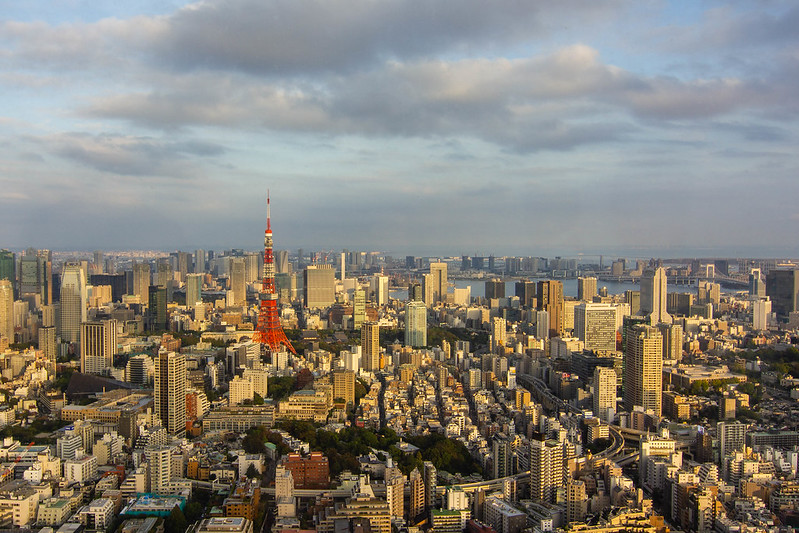
DAY ONE: AKIHABARA, UENO, & YANESEN

Otherworldly Akihabara
As a solo traveler, I typically like to start my trips with a free walking tour so I can wrap my head around my destination's history, and possibly meet some new travel companions along the way. Powering through the jet lag, I spend my first morning on the Tokyo Localized walking tour from Akihabara Station to Ueno Park.
Akihabara is electric. Literally. This neighborhood abounding with arcades, electronic stores, and anime cafes is known for being the center of otaku (geek) culture. Though I've never been one for video games, I appreciated this corner of Tokyo for all of its unabashed eccentricities.
The one thing I couldn't get on board with in Akihabara were the "maid cafes", where waitresses dress in French maid costumes and call their patrons "master". Locals assured me it's not actually sexist or degrading, but the whole scenario made my inner angry feminist cringe.
Akihabara is electric. Literally. This neighborhood abounding with arcades, electronic stores, and anime cafes is known for being the center of otaku (geek) culture. Though I've never been one for video games, I appreciated this corner of Tokyo for all of its unabashed eccentricities.
The one thing I couldn't get on board with in Akihabara were the "maid cafes", where waitresses dress in French maid costumes and call their patrons "master". Locals assured me it's not actually sexist or degrading, but the whole scenario made my inner angry feminist cringe.

Ameyoko Market
After our walking tour wrapped up in the sprawling Ueno Park, I walked down to Ameyoko Market for some yakitori fresh off the grill. Though being Celiac in Japan can be frustrating and at times discouraging, grilled yakitori with salt, shio, is usually a safe backup option. Steer clear of the yakitori marinated with sweet and savory sauce, tare, which contains soy sauce with wheat.
I strolled back up through Ueno Park's flourishing landscapes, slowly making my way to the Tokyo National Museum. Home to the world's largest collection of Japanese art, this museum completely enthralled me. With most of it being completely new to me, I eagerly soaked up and savored the art, history, and stories this museum had to offer.
Though my feet were already aching from the day's many steps (and let's be real, of course I didn't wear the right shoes), I continued my walk towards the quiet Nezu-jinja Shrine. One of Japan's oldest shrines, its opulent architecture stands in striking contrast to the lush greenery that surrounds it. Even though much of Tokyo was destroyed in WWII or in 2011's devastating earthquake, the shrine's structure is still mostly in tact from the mid-Edo period. You wouldn't be able to tell, given the noticeable lack of crowds here.
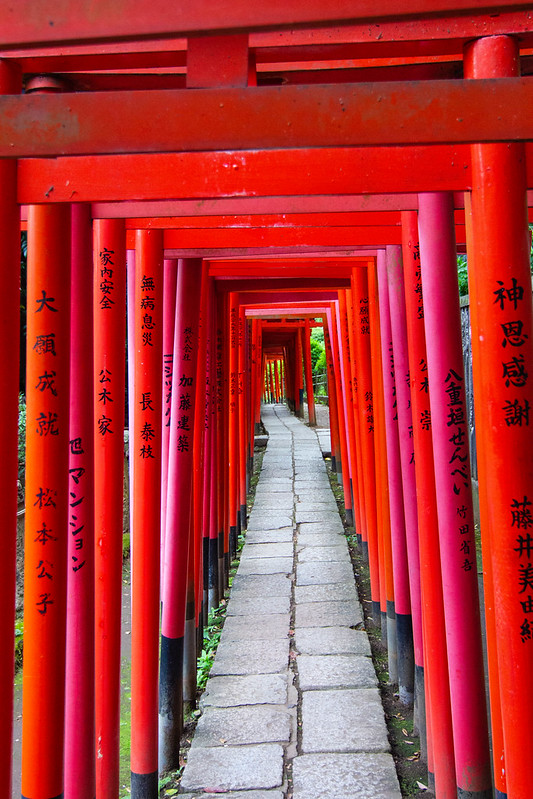
Bright torii gates at Nezu-jinja
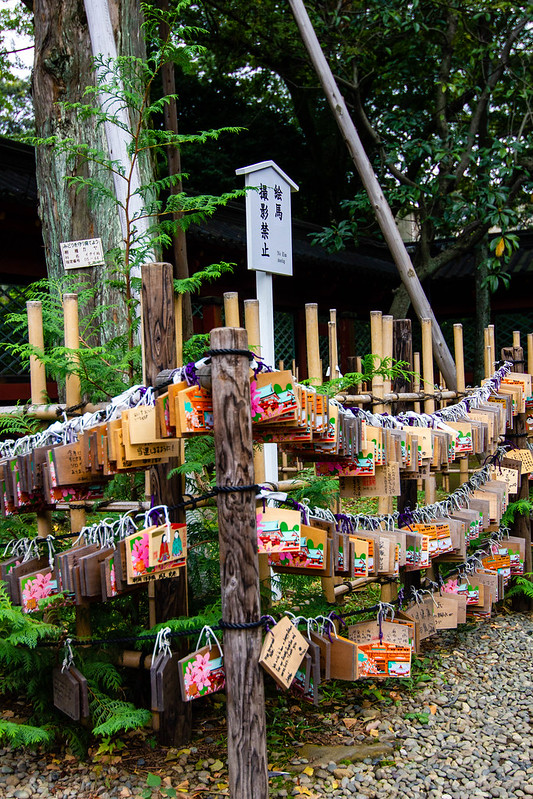
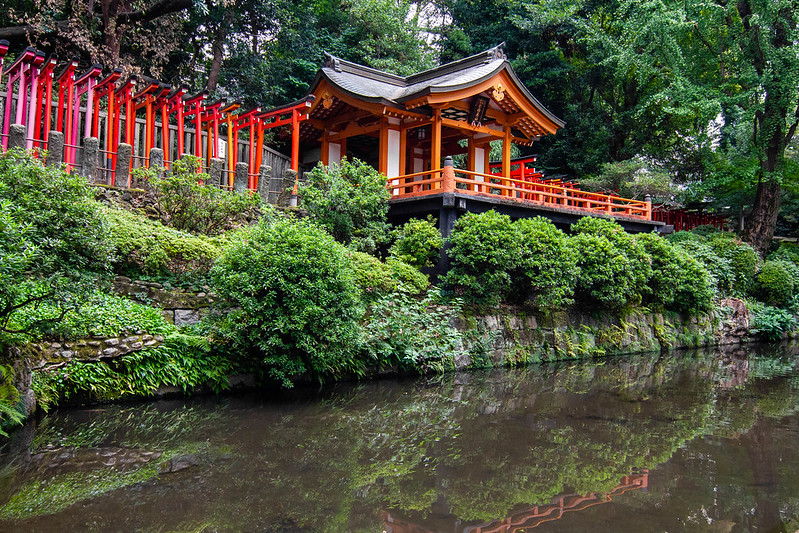
Serene escapes at the Nezu-jinja Shrine
After getting in my daily fix of nature and shrines, I wandered to Yanaka Ginza, a vintage pedestrian street lined with traditional shops. Selling fresh produce, ceramics, sweets, and other local delicacies, strolling down this street is like stepping back in time to the mid-20th century.
All of the nostalgic shops along Yanaka Ginza had my stomach growling, so I celebrated a successful first day in Tokyo with dinner at Little Bird Cafe. A haven for Celiacs and the gluten intolerant, the menu here is 100% gluten-free. (It also boasts an impressive array of dairy-free options as well.)
Just a stone's throw from Yoyogikoen Station near Harajuku, the location was a bit tricky to find, as the restaurant is located in a converted apartment on the fourth floor. I feasted upon the gluten-free gyoza and ramen, as well as a chocolate and banana rice cream puff. Thrilled by the fact I could actually eat ramen in Tokyo, I committed to becoming a daily regular here.
Just a stone's throw from Yoyogikoen Station near Harajuku, the location was a bit tricky to find, as the restaurant is located in a converted apartment on the fourth floor. I feasted upon the gluten-free gyoza and ramen, as well as a chocolate and banana rice cream puff. Thrilled by the fact I could actually eat ramen in Tokyo, I committed to becoming a daily regular here.
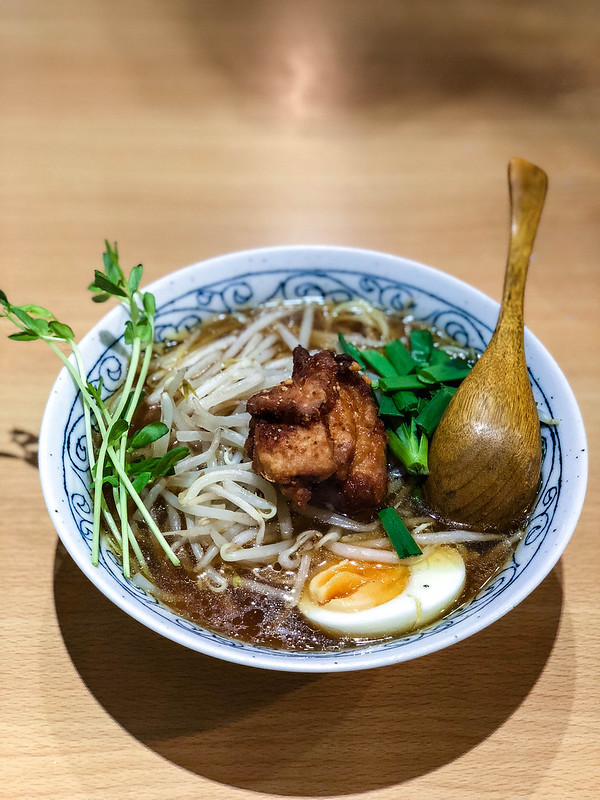
Gluten-free ramen from Little Bird Cafe
DAY TWO: SHIBUYA, HARAJUKU, & SHINJUKU
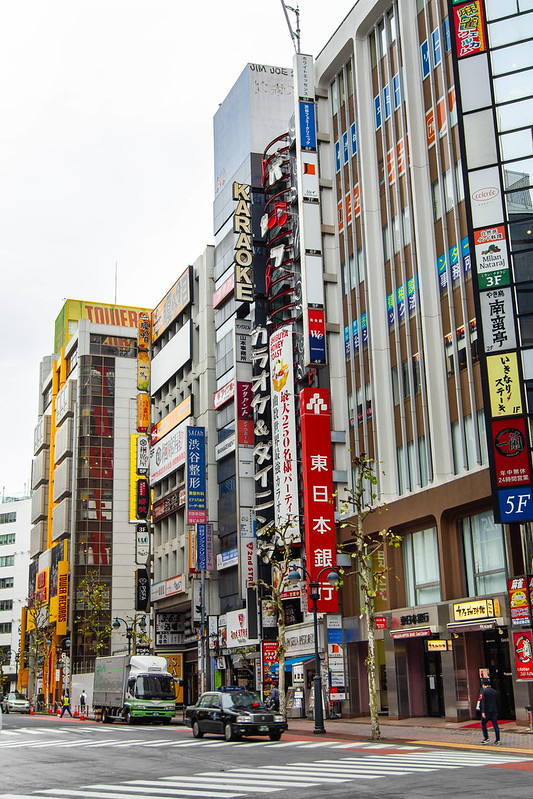
Colorful streetscapes of Shibuya
The organized chaos of Shibuya Crossing, the busiest intersection in the world, is relatively unparalleled. Mincing through the mob, I made my way through Shibuya Center-gai, silently questioning why I put this on my itinerary when I truly abhor crowds. Too organized and efficient to be full-on pandemonium, this place is still an introvert's nightmare.
Suffice it to say, I was thankful to seek refuge in Tokyu Hands, a quirky department store selling everything from couture to craft supplies. Offering a myriad of miscellaneous goods, this was my favorite spot to pick up souvenirs, such as kawaii (cute) stationary, washi tape, and plush sushi dog toys.
Before venturing onward to Harajuku, I visited the Meiji-jingu Shrine. The capital's most iconic Shinto shrine is marked by a gargantuan torii gate at the entrance, with the masses leading you into a forested oasis. The shrine was destroyed in WWII, but rebuilt soon afterwards.
Suffice it to say, I was thankful to seek refuge in Tokyu Hands, a quirky department store selling everything from couture to craft supplies. Offering a myriad of miscellaneous goods, this was my favorite spot to pick up souvenirs, such as kawaii (cute) stationary, washi tape, and plush sushi dog toys.
Before venturing onward to Harajuku, I visited the Meiji-jingu Shrine. The capital's most iconic Shinto shrine is marked by a gargantuan torii gate at the entrance, with the masses leading you into a forested oasis. The shrine was destroyed in WWII, but rebuilt soon afterwards.

Donated sake barrels at Meiji-jingu

Already drained from the crowds of Shibuya and Meiji-jingu, I needed to recharge somewhere peaceful. Serendipitously, I stumbled upon Mocha Cat Cafe in Harajuku. Being the crazy cat lady that I am, I relished the quiet escape (and kitty cuddles).
Refreshed and restored, I now had the energy to take on Takeshita-dori, Harajuku's main thoroughfare filled with offbeat boutiques, quirky cafes, and colorful restaurants. The beating heart of Japan's kawaii culture, Harajuku is both elegant and outlandish.
On Takeshita Street, imaginative boutiques feature young and colorful statement pieces, while wandering further into the neighborhood will reveal more high fashion alternatives. From the local artwork and handicrafts of Design Festa Gallery to the nostalgic and childlike clothing at Nile Perch, Harajuku's varied offerings are just as fascinating and diverse as the neighborhood itself.
The closer I got to the upscale neighborhood of Omotesando, the more chic the streets were. With its high end shops, contemporary architecture, and grand tree-lined avenue, it was clear that luxury in Tokyo lives here. I stopped by Revive Kitchen Three Aoyama for a gluten-free lunch that was delightfully fresh, light, and unabashedly bougie.
On Takeshita Street, imaginative boutiques feature young and colorful statement pieces, while wandering further into the neighborhood will reveal more high fashion alternatives. From the local artwork and handicrafts of Design Festa Gallery to the nostalgic and childlike clothing at Nile Perch, Harajuku's varied offerings are just as fascinating and diverse as the neighborhood itself.
The closer I got to the upscale neighborhood of Omotesando, the more chic the streets were. With its high end shops, contemporary architecture, and grand tree-lined avenue, it was clear that luxury in Tokyo lives here. I stopped by Revive Kitchen Three Aoyama for a gluten-free lunch that was delightfully fresh, light, and unabashedly bougie.

Making friends at Mocha Cat Cafe

A deluge of tourists on Harajuku's Takeshita-dori

Eccentric shops in Harajuku
Despite my quaint little business hotel being centrally located in Shinjuku, I had yet to explore the neighborhood beyond its sprawling (and somewhat overwhelming) Shinjuku Station. On my second night in Tokyo, I joined the the Tokyo Localized Shinjuku Night walking tour with a new travel buddy from my first day's tour.
Though Tokyo itself is incredibly safe, Shinjuku has some seedy eccentricities that mesmerized me. Like listening to titillating gossip, I loved hearing a local guide's perspective on the complex history of organized crime, "love hotels", and the serious debt that people can get into from frequenting escort bars.
Our tour ended in Shinjuku's Golden Gai, a maze of tiny dive bars that began as a black market after WWII. Each bar has a theme and only fits 5-10 people, and some bars don't even allow foreigners. In the ones that do, you're sure to meet people from all over the world. Despite intending to bar crawl, we settled into one particularly cozy bar for some smooth sake and good conversations.
Though Tokyo itself is incredibly safe, Shinjuku has some seedy eccentricities that mesmerized me. Like listening to titillating gossip, I loved hearing a local guide's perspective on the complex history of organized crime, "love hotels", and the serious debt that people can get into from frequenting escort bars.
Our tour ended in Shinjuku's Golden Gai, a maze of tiny dive bars that began as a black market after WWII. Each bar has a theme and only fits 5-10 people, and some bars don't even allow foreigners. In the ones that do, you're sure to meet people from all over the world. Despite intending to bar crawl, we settled into one particularly cozy bar for some smooth sake and good conversations.
Not far from Golden Gai is Omoide Yokocho, or Memory Lane, a narrow alley lined end to end with tiny bars and simple street food. (Over time, it garnered the nickname "Piss Alley" for its notable lack of restrooms.) Most stalls specialize in grilled yakitori skewers, which is the perfect late night snack after ample sake consumption in Golden Gai.

Shinjuku after dusk

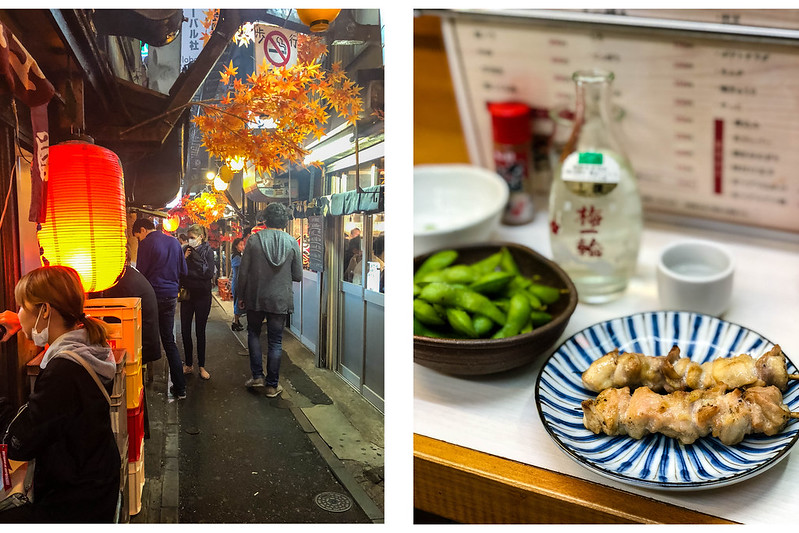
Late night yakitori in Omoide Yokocho
DAY THREE: ROPPONGI HILLS

Needing to slow down the pace due to sensory overload (and a mild sake hangover), I took it easy the next day. I leisurely lunched at Little Bird Cafe for some gluten-free yakisoba noodles, and slowly made my way to Roppongi Hills.
My first stop was the Mori Art Museum, featuring thought-provoking contemporary art. I'm never ceased to be amazed by modern art's ability to convey cultural complexities. My museum ticket was included with entrance to the Tokyo City View, which boasts sublime 360-degree views of the city's never-ending sprawl from the 52nd floor.
With the weather permitting, I ventured even higher to the Sky Deck to walk around the building's helicopter pad, soak in even more striking vistas, and feel grateful that I am not afraid of heights. Naturally, I polished off my adventure with a glass of champagne at the Sky View Bar.
With the weather permitting, I ventured even higher to the Sky Deck to walk around the building's helicopter pad, soak in even more striking vistas, and feel grateful that I am not afraid of heights. Naturally, I polished off my adventure with a glass of champagne at the Sky View Bar.
Not quite yet getting my fill of the city's dazzling panoramas, after dusk I ventured to the Tokyo Metropolitan Government building to watch Shinjuku sparkle at night from the 45th floor's public observation deck.
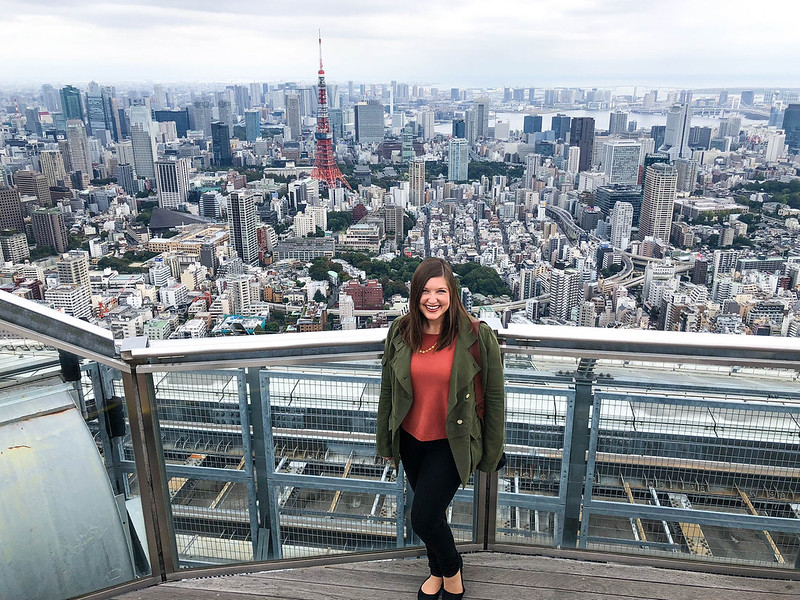
Views from the Tokyo City View's outdoor Sky Deck

DAY FOUR: TSUKIJI MARKET & ASAKUSA

Once home to the world's largest and busiest fish market, Tokyo's Tsukiji Market is still thriving. Packed along a maze of winding streets, vendors hawk everything from fresh food to kitchen tools. Between the stalls of intriguing seafood, colorful matcha, tempting sweets, and exotic produce, I took my time investigating the local delicacies.
Despite my food allergies, markets are always my top priority to visit in a new destination. I've always been one to sightsee through my tastebuds, and I'm a firm believer that you can learn more from a culture through its cuisine. Exploring the packed and pungent Tsukiji Market was no exception, and despite not indulging on anything, it was still a highlight of my trip.
Despite my food allergies, markets are always my top priority to visit in a new destination. I've always been one to sightsee through my tastebuds, and I'm a firm believer that you can learn more from a culture through its cuisine. Exploring the packed and pungent Tsukiji Market was no exception, and despite not indulging on anything, it was still a highlight of my trip.



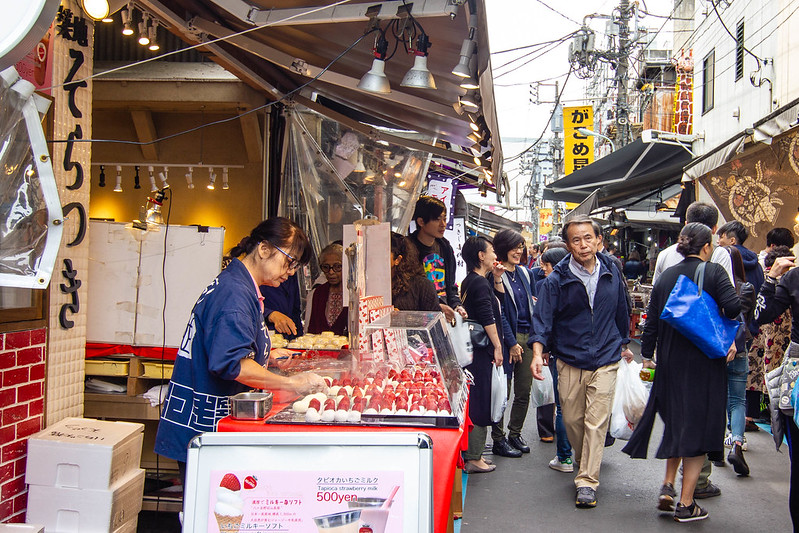
Having previously met a fellow gluten-free solo traveler at Little Bird Cafe, we met up for lunch at Soranoiro under Tokyo Station. Catering to hungry commuters on the go, Tokyo Station has an entire underground level packed with decent eateries and ramen shops that are much more elevated than your average food court.
I ordered gluten-free veggie ramen from Soranoiro's vending machine, which may be something completely ordinary for locals, but was honestly the highlight of my day. One of my favorite things about Tokyo was finding joy in the mundane, from standing in line to board the metro to using fancy toilets that play music to distract you.
As somewhat of a germaphobe, I am completely on board with taking off your shoes at restaurants or hotel rooms, and even having a separate pair of slippers exclusively for the bathroom. And is there anything more luxurious than being served a warm towel to wipe your hands before a meal? Life in Japan is impeccably efficient and organized, which for someone who is undoubtedly Type A, I found incredibly pleasing.
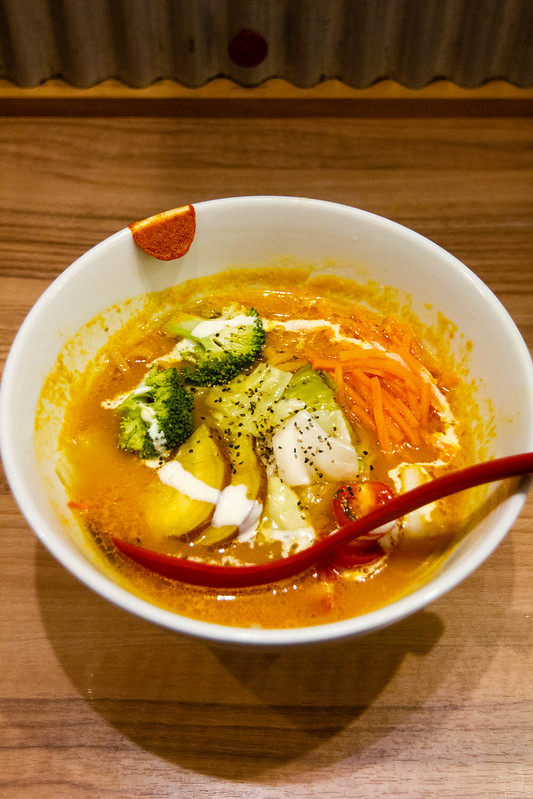
Gluten-free veggie ramen from Soranoiro
No trip to Tokyo would be complete without an adventure to Asakusa, so I spent the better part of my afternoon exploring its many shops, curiously observing the hordes of tourists in kimonos, and wandering the grounds of the stunning Senso-ji Temple.
Senso-ji is Tokyo's most famous Buddhist temple and pilgrimage site, and it's certainly the most crowded. I found it difficult to aimlessly wander, as I was constantly stumbling through someone's selfie or wannabe-influencer photoshoot in questionably culturally appropriated clothing.
By day four, Tokyo's sullen silver skies and swarms of people had depleted my energy. In hindsight, I really should have taken a rural day trip to a mountainous onsen, or at least one that allows tattoos, since mine precluded me from entering some of the mainstream and highly recommended hot springs and bathing houses.
Though there was still so much to see and experience in Tokyo, I felt more than ready to escape the bustling energy of the city in favor of a more peaceful retreat. Next stop, Kyoto.

There's no shortage of shopping in Asakusa


Asakusa's notorious Senso-ji
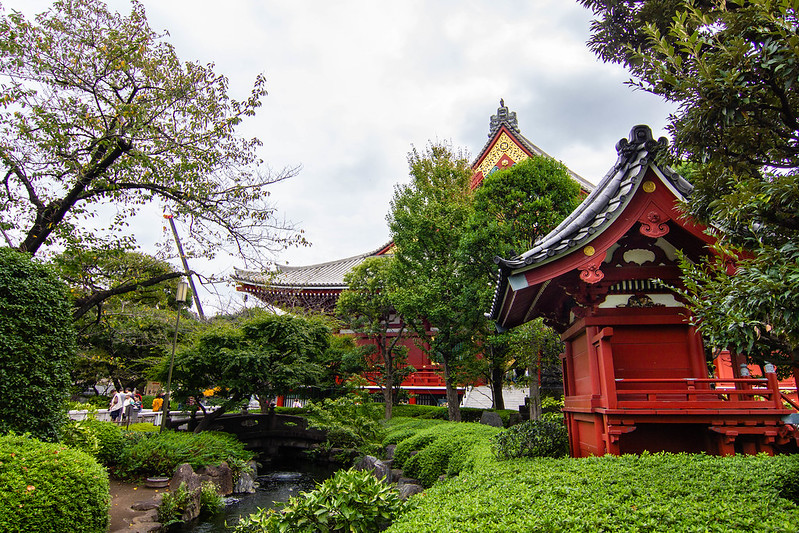
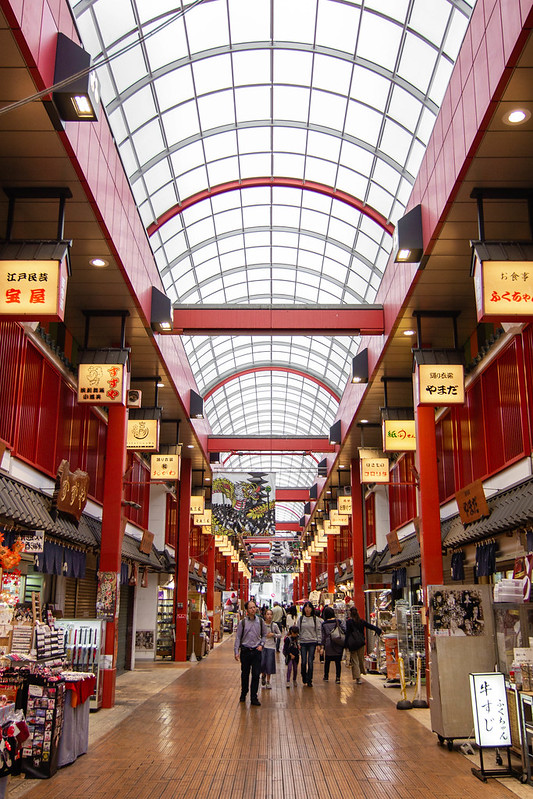
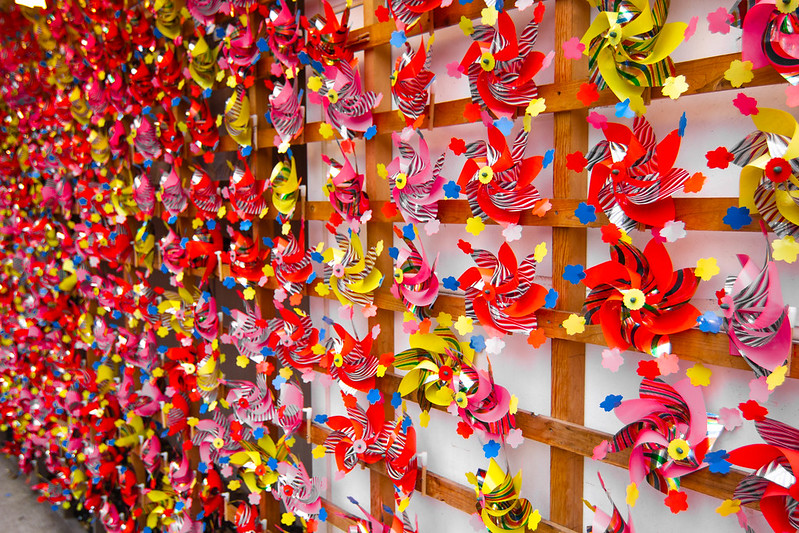
Having spent a considerable amount of time in Scandinavia and Japan in 2018, I've been inspired and challenged by these collectivist cultures. Conformity, complacency, and conflict avoidance seem to be hallmarks of these organized and well-functioning societies. Everybody abides by the rules and avoids disturbing anyone in their surroundings.
While I find it incredibly admirable that people genuinely look out for one another and value the wellbeing of their community, I am still thankful that I live in an individualistic society, for I am undoubtedly one to question authority. I maintain a visceral rejection of "group think" mentality, although I can appreciate its effects on making a society efficient, logical, and safe.
However, one value I can't seem to wrap my head around is the concept of respect. I respect everyone on a fundamentally human level, but serious respect - perhaps "reverence" is a better word for it - is something that I see as needing to be earned. The deeply entrenched value of respecting one's elders is one I can't seem to abide by. Just because someone has been alive longer doesn't necessarily mean that they're always right, or that they make the best decisions.
Also, the foundation of this concept has inherently sexist roots. Women defer to men, men defer to older men, and thus perpetuates the patriarchy.
My time in Tokyo was often spent observing and wanting to know more about women's roles in society. I wasn't aware of the acute gender inequality until I actually visited and did some research. It pained me to witness very few women in business attire on the metro during rush hour. Most locals told me that the majority of women often stick to jobs like teachers, nurses, or homemakers, rarely venturing beyond traditional gender roles. I'm sure there are plenty of exceptions (and my experience as a visitor is purely anecdotal), so if any readers out there have any other experiences or observations, I'd love to hear about them. Feel free to comment below or drop me an email; let's discuss!

As it turns out, being an introverted, tattooed feminist with Celiac disease in Tokyo was really f*cking hard. I was exhausted, I was challenged, and I was constantly hungry. But that didn't stop me from loving the city any less. I definitely had an easier time in Kyoto, but Tokyo got under my skin and stayed there.
Have you ever been to a place that exhausted and challenged you, but you still loved it?
Thus Article Four Days in Tokyo
That's an article Four Days in Tokyo This time, hopefully can give benefits to all of you. well, see you in posting other articles.
You are now reading the article Four Days in Tokyo with the link address https://objectours.blogspot.com/2019/12/four-days-in-tokyo.html
0 Response to "Four Days in Tokyo"
Post a Comment